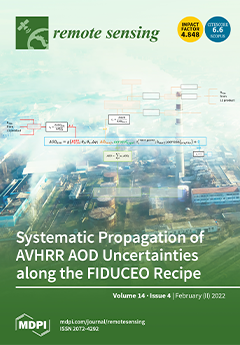Open AccessEditor’s ChoiceArticle
Decadal Lake Volume Changes (2003–2020) and Driving Forces at a Global Scale
by
Yuhao Feng, Heng Zhang, Shengli Tao, Zurui Ao, Chunqiao Song, Jérôme Chave, Thuy Le Toan, Baolin Xue, Jiangling Zhu, Jiamin Pan, Shaopeng Wang, Zhiyao Tang and Jingyun Fang
Cited by 14 | Viewed by 3824
Abstract
Lakes play a key role in the global water cycle, providing essential water resources and ecosystem services for humans and wildlife. Quantifying long-term changes in lake volume at a global scale is therefore important to the sustainability of humanity and natural ecosystems. Yet,
[...] Read more.
Lakes play a key role in the global water cycle, providing essential water resources and ecosystem services for humans and wildlife. Quantifying long-term changes in lake volume at a global scale is therefore important to the sustainability of humanity and natural ecosystems. Yet, such an estimate is still unavailable because, unlike lake area, lake volume is three-dimensional, challenging to be estimated consistently across space and time. Here, taking advantage of recent advances in remote sensing technology, especially NASA’s ICESat-2 satellite laser altimeter launched in 2018, we generated monthly volume series from 2003 to 2020 for 9065 lakes worldwide with an area ≥ 10 km
2. We found that the total volume of the 9065 lakes increased by 597 km
3 (90% confidence interval 239–2618 km
3). Validation against in situ measurements showed a correlation coefficient of 0.98, an RMSE (i.e., root mean square error) of 0.57 km
3 and a normalized RMSE of 2.6%. In addition, 6753 (74.5%) of the lakes showed an increasing trend in lake volume and were spatially clustered into nine hot spots, most of which are located in sparsely populated high latitudes and the Tibetan Plateau; 2323 (25.5%) of the lakes showed a decreasing trend in lake volume and were clustered into six hot spots—most located in the world’s arid/semi-arid regions where lakes are scarce, but population density is high. Our results uncovered, from a three-dimensional volumetric perspective, spatially uneven lake changes that aggravate the conflict between human demands and lake resources. The situation is likely to intensify given projected higher temperatures in glacier-covered regions and drier climates in arid/semi-arid areas. The 15 hot spots could serve as a blueprint for prioritizing future lake research and conservation efforts.
Full article
►▼
Show Figures





